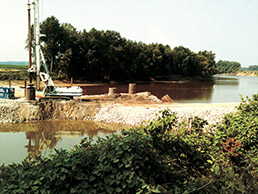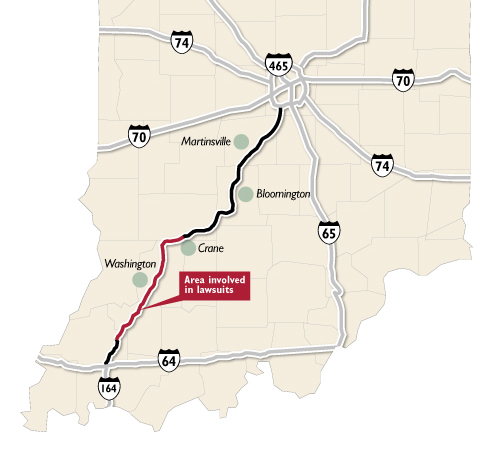Subscriber Benefit
As a subscriber you can listen to articles at work, in the car, or while you work out. Subscribe NowPictures are worth a thousand words, at least that’s what Bloomington attorney Mick G. Harrison thinks when he sees images of where Interstate 69 is being extended in southern Indiana.
The land is “bleeding,” what Harrison describes as the soil severely eroding away and being washed into the water. A narrow interstate crossing taking shape over the East Fork of the White River near Washington has a steel beam sticking up in the river channel with accumulated garbage caught by the construction material and polluting the water.
Local residents see water bubbling up through the sandy soil and bringing down the overall level of the area’s water tables, meaning wells for their homes have gone dry. Birds and wildlife appear to be losing their natural habitat.
 One environmental impact that concerns opponents of the Interstate 69 route is a bridge being built over the East Fork of the White River in southern Indiana. The Hoosier Environmental Council says that the crossing is damaging floodplains and obstructing the flow of water, changing the ecology of the river and nearby farmland. (Submitted photo)
One environmental impact that concerns opponents of the Interstate 69 route is a bridge being built over the East Fork of the White River in southern Indiana. The Hoosier Environmental Council says that the crossing is damaging floodplains and obstructing the flow of water, changing the ecology of the river and nearby farmland. (Submitted photo)Those pictures are shocking, Harrison says. But he insists that what’s not displayed is just as dreadful to those concerned about the local environment. Absent from most of the pictures are the Indiana bats and migratory birds that the environmental attorney knows are already considered endangered. He fears they might become even more in jeopardy with the new I-69 route. He’s concerned about the decreased air quality once new cars begin using the road.
“Each is significant by itself, but the combination of violations show shocking concealment during what was supposed to be a public process,” said Harrison, who represents the Hoosier Environmental Council in lawsuits targeting the I-69 project.
Whether those examples and other potential situations rise to the level of environmental law violations is the focus of three federal lawsuits filed this year challenging the construction of the interstate between Indianapolis and Evansville.
Indianapolis environmental attorney Curt DeVoe with Plews Shadley Racher & Braun is not involved with the I-69 litigation, but he said many of the issues that appear to be raised in the cases are common in these types of lawsuits. Issues involving the Clean Water Act, wetlands, endangered species and architectural or historical components intersect in these types of suits, he said.
“The problem is that these projects span so much area in linear feet of highway and other land or construction, but they have to cross water or follow whatever engineering line it’s designed to have,” he said. “That heightens the environmental impact, and you have to balance both environmental and economic costs.”
The litigation alleges that the $3 billion project stretching 142 miles began and is moving forward despite numerous environmental violations. The legal challenges also allege state and federal officials, both in the transportation and environmental arenas, intentionally disobeyed law by approving the project on that route rather than choosing a more environmentally safe and less-costly alternative path.
For years, residents and environmentalists have been fighting the planned I-69 route that crosses some of the most environmentally sensitive parts of the state. Construction began in 2009 near Evansville on the first section. Opponents prefer a slightly longer route that would consist of upgrades to I-70 in western Indiana and an interstate-conversion for U.S. 41 toward Evansville – alternatives they argue would be less costly and less damaging to the environment.
Harrison said unless the state delays the project until all the potential environmental violations are re-examined, winning the litigation would
mean Indiana would have to go back to the drawing board on a new proposed route that has less of an environmental footprint.
 The Hoosier Environmental Council and Citizens for Appropriate Rural Roads filed a lawsuit in October that alleges the U.S. Army Corps of Engineers violated the Clean Water Act of 1970 when issuing a permit for construction on Section 2, which includes 29 miles of interstate between Oakland City and Washington. That permit allows for 644,802 cubic yards of fill in wetlands located in Pike and Daviess counties, including the Patoka River National Wildlife Refuge and Wildlife Management Area. The fill, as part of a 25-foot-high causeway stretching 2.5 miles, would connect a White River bridge and two other tributary bridges.
The Hoosier Environmental Council and Citizens for Appropriate Rural Roads filed a lawsuit in October that alleges the U.S. Army Corps of Engineers violated the Clean Water Act of 1970 when issuing a permit for construction on Section 2, which includes 29 miles of interstate between Oakland City and Washington. That permit allows for 644,802 cubic yards of fill in wetlands located in Pike and Daviess counties, including the Patoka River National Wildlife Refuge and Wildlife Management Area. The fill, as part of a 25-foot-high causeway stretching 2.5 miles, would connect a White River bridge and two other tributary bridges.
In the lawsuit, the environmental groups say engineers are required by the Clean Water Act to find practical alternatives to proposed discharges that would have fewer adverse impacts on aquatic life. This suit is similar to one filed by the same two groups in February, which focused on a different part of the project – Section 3 – stretching 26 miles between Washington and Crane and crossing six streams and rivers. In that earlier suit, the plaintiffs allege the Army Corps never conducted a thorough, independent review of the permit application as required by Section 404 of the federal Clean Water Act, and therefore the process wasn’t adequate in granting the permit that authorized INDOT to reroute streams and fill in wetlands. The lawsuit also included claims that environmental violations happened because historic bridges in those areas weren’t properly protected.
A third suit filed in August adds to the list of environmental violation allegations. The HEC claims that federal highway officials failed to review the alternatives to the planned route and, as a result, violated the Endangered Species Act and National Environmental Policy Act. The suit claims the route is threatening Indiana’s endangered bat population by removing trees and impacting the natural habitat such as marshes and caves where the species live.
“To us, the bottom line about why this I-69 project is such an objectionable process is that the state’s bent over backwards to build a costly and environmentally damaging highway,” HEC senior policy director Tim Maloney said. “That the state continues pursuing this, even now when all this is out there, is just really beyond comprehension.”
Briefing is ongoing in each of the lawsuits, and Harrison expects a preliminary injunction hearing on the newest lawsuit to happen sometime early next year.
INDOT spokesman Will Wingfield said the department’s policy is to not to comment on pending litigation, but generally he said that “the state and Federal Highway Administration have completed extensive environmental studies that meet or exceed federal requirements.”
Tim Horty, public information officer in the U.S. Attorney’s Office in Indianapolis, declined to discuss specifics of the project or pending litigation. But he said protecting the environment has always been a priority for state and federal officials involved with the I-69 project.
“We’re sensitive to the environmental issues, of course, and we don’t want to sour the environment any more than anyone else,” he said. “But there’s a process that must be followed and we’re doing everything we can to abide by that. If the court allows the construction to continue, then that will remain a priority.”•
Please enable JavaScript to view this content.
